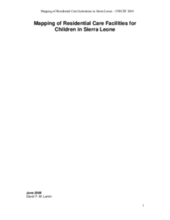Sierra Leone is one the world’s poorest countries, ranked 177/177 in 2007 on the Human Development Index and has an estimated population of five million, 51% of whom are children. 11.3% of these children (283,000) are orphans having lost one or both parents as a result of the ten year civil war, low life expectancy in the country, HIV/AIDS and a host of other factors. 20.3% of the child population does not live with their biological parents who are alive.
Poverty coupled with ignorance of children’s rights, many of which are now enacted in the Child Rights Act, poor parenting skills, the absence of child friendly bye laws at community level, culture and a host of other factors have excluded Sierra Leonean children from adequate access to education and health care, water and sanitation facilities, emotional support and other basic services and has made them vulnerable to varying degrees of exploitation and abuse. While Sierra Leonean children are generally at risk of various forms of abuse and exploitation whether living with or away from biological parents, orphans seem to be at a greater risk as found out by the Vulnerability and Capacity Research conducted in 2006 by UNICEF.
Efforts to address the country’s poverty especially meeting the Millennium Development Goals (MDGs), as they pertain to children, remain a serious challenge. In addition to orphans and children living away from home there is also a large number of other vulnerable children including children living in the street, those living in a household headed by an elderly person or a child, those living in households where adults are terminally sick or households in dire poverty. Children growing up in such circumstances are ‘vulnerable children’. 18.2% of Sierra Leonean children are considered as vulnerable (MICS III, 2005). The MICs III also identified 26.7% of Sierra Leonean children as orphans and vulnerable children.
The MSWGCA which is responsible for all child welfare and protection issues including vulnerable and excluded children (VEC) is not able to coordinate and monitor the provision of services to VEC. This is mainly because the MSWGCA lacks basic information on NGOs working for VEC and on children’s residential care institutions in particular.
To help the ministry perform its duties the VEC task force was established in 2004 that provides the forum for coordination. The task force was established with the support of UNICEF.
The Task Force has identified the need for a mapping of NGOs working for VEC, their interventions, how many children they reach, etc. This can be the basis for the Ministry to better monitor and coordinate the work of the NGOs and identify gaps in the care for VEC.
Furthermore the Task Force identified an urgent need for a nation-wide mapping of existing facilities caring for children on an overnight basis, including information on their policy, standards, their sources and means of funding, staffing, record keeping, the number of children, reasons for their admission, quality of care provided for them and children’s access to social services in residential care institutions. The research was also to look at the authority of institutions to care for children and the standards and guidelines used in the management of residential care institutions.
Results from these two mapping exercise will be used in cooperation with residential care institutions to develop minimum standards of care and protection. A regulatory framework will also be developed, guiding the implementation of the minimum standards, and the licensing and monitoring of the institutions by the government
At the same time, reintegration of children in child care institutions back into their communities will be dealt with on a case by case basis and in the best interest of the child. Also community based solutions for caring for VEC will be promoted to prevent children from entering into children’s institutions in the first place.

